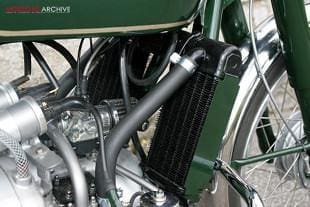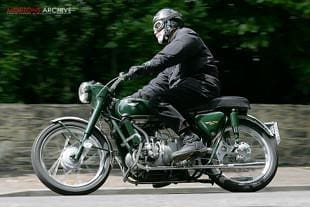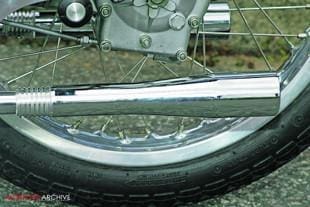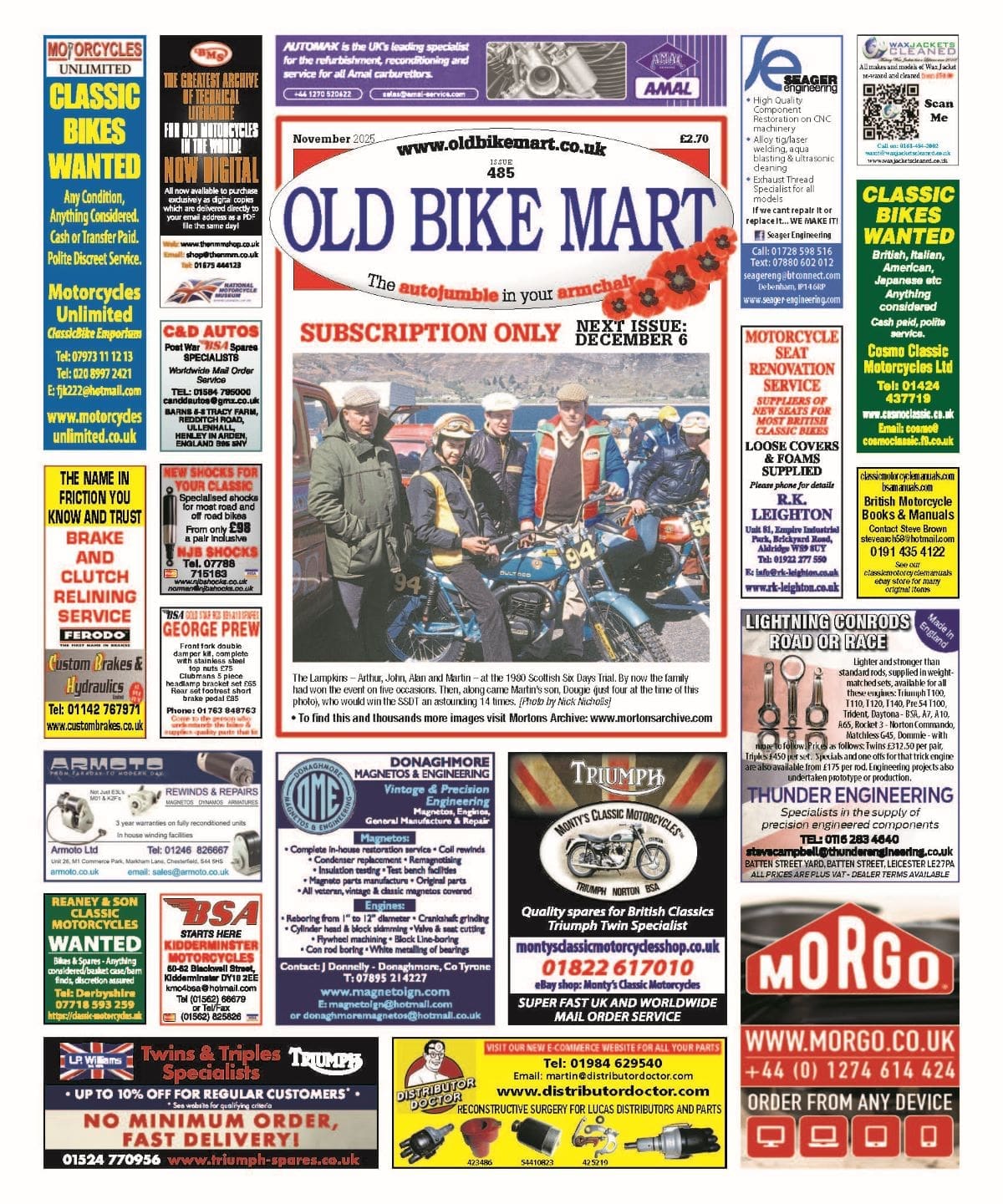
Owner and builder Ian Munro admits that when people learn he’s fitted a Velocette LE engine into a Velocette Valiant frame they tend to ask, “Why?” rather than exclaim, “Wow!” On the face of it, that’s understandable. The Valiant’s greatest perceived failing was that merely crafting overhead valves onto Velocette’s flat twin engine didn’t result in performance that matched its image and price, so replacing it with the more sedate side-valve version doesn’t seem a very clever idea.
However, when you put the facts the other way round, an LE-engined Valiant begins to make sense. The Valiant’s price and specification led some riders to expect that it would give quarter-litre performance, and while its bottom end was stronger than that of the LE, it could prove fragile if thrashed to the limit. The sv ‘Little Engine’, on the other hand, had been progressively developed so that its stamina matched its capabilities.
 So, Valiant frames outnumber Valiant engines, and if you have a frame lying around in the shed – as Ian Munro did – he can counter the question of why he fitted it with an LE power unit by asking “Why not?”
So, Valiant frames outnumber Valiant engines, and if you have a frame lying around in the shed – as Ian Munro did – he can counter the question of why he fitted it with an LE power unit by asking “Why not?”
Enjoy more classic motorcycle reading, Click here to subscribe to one of our leading magazines.
He’s not alone in coming to that conclusion, and LEVals – as they are usually known – are an accepted aspect of flat-twin Velo-land. “You’d better not call my bike a LEVal, though,” cautions Ian, “That usually refers to an LE engine powering an otherwise-complete Valiant, while mine is a mixture of components and the purists might object.” Well, regular readers will know my distain for such sniffy attitudes, but to avoid Ian being ostracised I agree to refer to his bike as an LE-Valiant Special. Personal experience tells me, however, that armchair motorcyclists will now say that it shouldn’t be called a Special either, since it embodies an engine and frame from the same manufacturer…
Anyway, having got that off my chest I can get on with enjoying my ride on the LE-Valiant Special, and enjoy it I do, because it’s FUN. It’s partly that it’s so completely different to any other British lightweight, and partly because everything works so well. Even the riding position is different, although I have to admit that it doesn’t totally match my tastes. A rearward setting of the footrests was essential to keep riders’ feet clear of the twin carburettors on the ohv Valiant (BMW-riders would feel right at home on one), and Ian has retained that position, even though it is not necessary with the more compact, single-carburettored LE engine. Well he does happen to like and own BMWs, so who am I to criticise? And he has repositioned the foot controls – the gearlever now has an adjustable bottle screw in its linkage – so that they can be operated effortlessly with my feet on the pegs.
 But what really makes the LE-Valiant Special fun to ride, and what would come as a surprise to BMW owners, is its featherweight yet manageable feel. The Valiant might have had a grown-up sort of design, but size-wise it was firmly in James Captain territory, and its weight wasn’t much greater, either. The frame was much more sophisticated than a Captain’s though – with a sturdy spine surmounting duplex lower rails and rear sub-frame – and its handling was as good as you’d expect from any Velocette, with a tighter turning circle and a lighter feel thrown in for good measure.
But what really makes the LE-Valiant Special fun to ride, and what would come as a surprise to BMW owners, is its featherweight yet manageable feel. The Valiant might have had a grown-up sort of design, but size-wise it was firmly in James Captain territory, and its weight wasn’t much greater, either. The frame was much more sophisticated than a Captain’s though – with a sturdy spine surmounting duplex lower rails and rear sub-frame – and its handling was as good as you’d expect from any Velocette, with a tighter turning circle and a lighter feel thrown in for good measure.
BMW-owners might also be surprised (I certainly was) that the use of a flat twin engine can result in a narrow motorcycle. But the aptly named Little Engine somehow seems even more unobtrusive here than in its own frame, and from the saddle it’s simply not visible. The only clue to the in-line crankshaft is that there’s a slight lean to the right when I tweak the throttle at a standstill and, interestingly, the fear of torque reaction and gyroscopic effects was apparently one of the reasons designer Charles Udall gave for not enlarging the Valiant’s engine beyond a nominal 200cc. That excuse never held water with so many BMWs around, though, and even in those gullible days it was obvious that making more use of the LE’s tooling was the real driving factor.
 The exceptional handling wouldn’t be much good without a willing engine, and the LE mill surprises and impresses me as much in this conventional frame, as it does in its own pressed metal chassis. If you haven’t had the pleasure of riding either type of machine, all I can say is that you should ignore bar-room gossips who tell you that a 200cc side valve is bound to be boringly gutless. Obviously it’s not going to be a ball of fire, and both the LE and Valiant would have been much more popular and successful bikes with 250cc power units, but the Little Engine is such an eager and temperament-free unit that you can’t help but enjoy using it to the full.
The exceptional handling wouldn’t be much good without a willing engine, and the LE mill surprises and impresses me as much in this conventional frame, as it does in its own pressed metal chassis. If you haven’t had the pleasure of riding either type of machine, all I can say is that you should ignore bar-room gossips who tell you that a 200cc side valve is bound to be boringly gutless. Obviously it’s not going to be a ball of fire, and both the LE and Valiant would have been much more popular and successful bikes with 250cc power units, but the Little Engine is such an eager and temperament-free unit that you can’t help but enjoy using it to the full.
The power may be a little up on standard as a result of using a modern carburettor. “I just fancied trying a Dellorto,” says Ian, “and, to my surprise, when I phoned the agents and told them what I was doing, they sent a ready-jetted unit that worked straight out of the box. Confirmed Velocette flat twin fan, and mutual friend, Roger Holyoake is on hand during the test (regular readers may remember that I reported on both his Valiant and LE in The Classic Motorcycle February 2002 and December 2006 respectively), and when I comment on the liveliness of the engine Roger confirms that it feels just as poky as his Valiant despite having one third less nominal horsepower. “It would probably run out of puff more quickly at the top end,” he adds, “but in normal riding I can’t really tell the difference.” Equally importantly, for everyday riding, starting the LE-Valiant is absolutely effortless. During my time with it, every time I pressed the kickstart (its idiosyncratic internal lever mechanism – this is a Velocette, after all) the engine started instantly and ticked over faultlessly.
 “Well I did choose the best engine,” claims Ian, “I shopped around and managed to buy a wrecked 1967 MkIII LE from a number plate dealer. The late-model engines were by far the best, with 12volt electrics powered by a Lucas alternator and regulated by a Zener diode. The bike had apparently been wrapped round a tree,” he continues, “but the engine was absolutely fine, and apart from a precautionary look inside the barrels, I’ve not touched it.” By the 1960s, nearly all LEs were bought by Police forces, of course, and Ian’s description of the damage gives me irreverent images of a village bobby involved in a desperate (and hopeless) chase after criminals in a getaway car, but the point is that Ian’s purchase gave him both the engine that he needed, and sundry other parts.
“Well I did choose the best engine,” claims Ian, “I shopped around and managed to buy a wrecked 1967 MkIII LE from a number plate dealer. The late-model engines were by far the best, with 12volt electrics powered by a Lucas alternator and regulated by a Zener diode. The bike had apparently been wrapped round a tree,” he continues, “but the engine was absolutely fine, and apart from a precautionary look inside the barrels, I’ve not touched it.” By the 1960s, nearly all LEs were bought by Police forces, of course, and Ian’s description of the damage gives me irreverent images of a village bobby involved in a desperate (and hopeless) chase after criminals in a getaway car, but the point is that Ian’s purchase gave him both the engine that he needed, and sundry other parts.
And that brings me on to the mods that he thinks might upset the purists, but which, to me, make his motorcycle all the more interesting, and worthy of the Special name-tag. The forks and headlight, for example came from the LE donor. To me they look pretty much the same and I reckon Velocette themselves did a fair amount of delving into the parts bin. The LE headlamp on Ian’s bike, for example, carries the ammeter and ignition/lighting switch just like a Valiant’s, while I note that some LEs have plain headlamps with the instruments and switches mounted in the legshields.
 The hubs are from the LE, too, and they were laced into aluminium rims (as specified for the earliest LEs) by Brickwood Wheel Builders (01722 712701). Genuine Velocette features end with the pattern dual seat, as used on Valiants and bigger Velocettes. It’s firm to the touch, but is well enough shaped to be surprisingly comfortable. It complements handlebars that are more LE-style than Valiant, but are actually neither. “We found them in a friend’s garage,” grins Ian, “and had to weld the mounting bracket onto them. Fortunately the bracket’s in the centre under the fork shroud, so I didn’t have to have them re-plated.”
The hubs are from the LE, too, and they were laced into aluminium rims (as specified for the earliest LEs) by Brickwood Wheel Builders (01722 712701). Genuine Velocette features end with the pattern dual seat, as used on Valiants and bigger Velocettes. It’s firm to the touch, but is well enough shaped to be surprisingly comfortable. It complements handlebars that are more LE-style than Valiant, but are actually neither. “We found them in a friend’s garage,” grins Ian, “and had to weld the mounting bracket onto them. Fortunately the bracket’s in the centre under the fork shroud, so I didn’t have to have them re-plated.”
The mudguards came ready plated, as well, and apparently the front one was intended for a Gilera, while Ian spotted the back one hanging in Ray Fisher’s Britbits emporium (01202 483675) and bought it without knowing its provenance. “Most pattern mudguards are intended for 19inch wheels, and look horrible when fitted over smaller ones” he explains, echoing a foible of my own, “So I was on the lookout for ones with a tighter radius. These, on the other hand, were actually intended for 17in wheels but I’ve managed to allow for that with smaller section tyres on my 18inch rims.”
‘The importers and owners convert many Indian-made Bullets into trials lookalikes with high-level exhaust pipes, so there’s no longer space for right hand toolboxes, which consequently often appear on autojumble stalls’
It won’t surprise special-builders to see that the toolboxes came from a Royal Enfield Bullet – one of the few motorcycles in current production that features traditional pressed steel boxes instead of plastic mouldings. The importers and owners convert many Indian-made Bullets into trials lookalikes with high-level exhaust pipes, so there’s no longer space for right hand toolboxes, which consequently often appear on autojumble stalls. Look closely at the left hand box on Ian’s LE-Valiant, and you’ll see the hinge on its top panel proving that it’s been inverted from its original orientation. It’s not a problem provided you catch the tools before they hit the floor when you open it! And, joking apart, I’m sure that tools will seldom be required on this very well-thought out and prepared machine.
The exhausts on this  machine are non-standard too, and came from more unusual sources. The front down pipes are standard lightweight Velocette fare, but whereas they feed into a box on the LE and dinky conventional silencers on the Valiant, here they terminate in tiny megaphone shaped mufflers. “They are intended for the tail-pipes of Volkswagen Beetles,” says Ian, “they were cheap to buy and they fitted straight on to even cheaper straight sections of pipe that are actually B&Q curtain rails!” He didn’t really want me to put that last item of information in my report, but it’s good to show that a bit of lateral thinking can save clever special builders the expense of specially made parts or unnecessary chrome plating.
machine are non-standard too, and came from more unusual sources. The front down pipes are standard lightweight Velocette fare, but whereas they feed into a box on the LE and dinky conventional silencers on the Valiant, here they terminate in tiny megaphone shaped mufflers. “They are intended for the tail-pipes of Volkswagen Beetles,” says Ian, “they were cheap to buy and they fitted straight on to even cheaper straight sections of pipe that are actually B&Q curtain rails!” He didn’t really want me to put that last item of information in my report, but it’s good to show that a bit of lateral thinking can save clever special builders the expense of specially made parts or unnecessary chrome plating.
The exhausts are supported by home-made brackets – based on the Valiant design – which also carry the pillion footrests. “I don’t intend to carry passengers,” he says, “but secondary rests are a legal requirement if you have a dual seat.” Overall, the system endows the LE-Valiant with an exhaust note totally unlike either the wheeze or the buzz of its two progenitors. A sonorous drone just about sums it up, and if you can imagine a 1950s sports car pulling hard in a highish gear, you’ll get a pretty good idea of what it’s like.
As I’ve noted, this combination of engine and frame is not unique, but as with all specials there’s more than one way of achieving the desired end. Naturally the engine fits in easily enough – it has the same basis, after all – but because there’s not enough room for the LE’s radiator in the standard cycle parts of the air-cooled Valiant, LEVal builders usually compensate by lowering the engine. Ian, however, managed to use the standard mounts (with a modified cross member under the crankcase front) and modified the radiator instead. How? “Oh, I just removed the centre part, chamfered off the corners of the matrix that were closest to the engine and soldered it up again,” he says with an airy confidence that’s amazingly impressive coming from a man who was desk-bound until his retirement.
 He does his own paintwork, too, and that’s quite unusual these days. The frame was already finished in Velocette’s dark green – not the most inspiring colour in my personal opinion – and a local factor mixed matching cellulose for the tank and sundries. Underneath the cellulose, Ian used two-pack primer, and he finished things off with two-pack lacquer. “It saves an awful lot of cleaning and polishing,” he says, half jokingly. The autojumble-bought petrol tank is quite Valiant-esque, but its initial application is unknown, and Ian didn’t recognise the shape of the badge indents that he’s now filled in and painted over.
He does his own paintwork, too, and that’s quite unusual these days. The frame was already finished in Velocette’s dark green – not the most inspiring colour in my personal opinion – and a local factor mixed matching cellulose for the tank and sundries. Underneath the cellulose, Ian used two-pack primer, and he finished things off with two-pack lacquer. “It saves an awful lot of cleaning and polishing,” he says, half jokingly. The autojumble-bought petrol tank is quite Valiant-esque, but its initial application is unknown, and Ian didn’t recognise the shape of the badge indents that he’s now filled in and painted over.
Such mysteries are all part of the fun of special building, and if the finished article looks all of a piece, and works well – and this one does both of those things in spades – then the fun continues whenever the result takes to the road.


